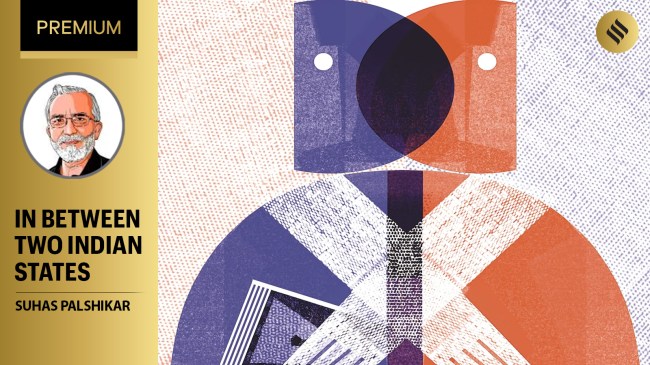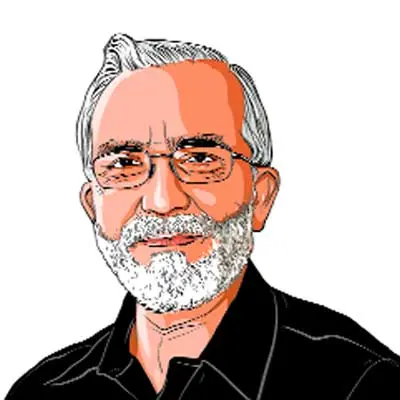Opinion Suhas Palshikar writes: We live in the midst of two state systems
The new one is long born and roams aggressively, the old one is not declared dead -- yet
 The first pathway is the replacement of constitutional symbolism by a symbolism of state-religion overlap. (Illustration by C R Sasikumar)
The first pathway is the replacement of constitutional symbolism by a symbolism of state-religion overlap. (Illustration by C R Sasikumar) This week witnesses an awkward face-off between two versions of the Indian state — the constitutional state and the Hindutva state. Recently, the RSS chief underlined his view that India got its true independence only on the day the Ram Temple at Ayodhya was consecrated. With the clout that he enjoys not only among RSS cadres but also among many outsiders who have discovered virtue in paying obeisance to the RSS and its chief, this edict about the formation of a true Indian state on January 22 last year will undoubtedly be taken seriously in many quarters. Juxtaposed with that, this week also witnesses commemoration of the day on which India’s republic was formed in 1950. However, the RSS chief bluntly put it, the republic that emerged from the freedom struggle and India’s independence on August 15 was lacking in the substance of “swa” – India’s self.
We thus have two distinct states, one normative and idealist, enshrined in the Constitution and another, a de facto Indian state, that is currently operating, marked by an explicit bluntness about its intent and content. For the time being, there will be efforts to reconcile the two ideas by claiming that there is no antagonism between the two; that the de facto state is only a true expression of the normative one. But this awkward co-existence warns us of the tension that marks the polity.
Even as the ideological debates continue over the nature of nationalism based on Hindutva, the nature of the Indian state has transformed in practice and now we shall witness legal and intellectual exercises aimed at making the new Indian state both legitimate and ideologically attractive. The last one year was marked by this silent move towards ensuring that the Hindutva state quietly replaces the constitutional republic of 1950.
As we are prone to connect everything to direct electoral dividends, it may appear ironical that the grand ceremony of consecration of the temple last January did not yield adequate benefit to the BJP. But it would be a mistake to underplay its significance. It is wrong to imagine either that the Ayodhya temple did not matter in shaping public sensibilities or that merely because of an electoral setback to the BJP, the constitutional republic is unchallenged. Notwithstanding the complex nature of electoral outcomes and even the less-than extreme public opinion on many matters, two things stand out: One is the steady push the Hindutva state is getting and the other is the consistent efforts to create demand and support for the new Hindutva state.
Imageries are not mere drapery, they are part of the design and, as such, expressions of content. In this sense, going back to the consecration ceremony is instructive. That ceremony was symbolic of the integration of the state with the idea of Hindutva. It depicted the prime minister not merely as a devotee attending the ceremony but also as the host and priest. That only the RSS chief had the place of pride alongside the prime minister during that ceremony underscored both that the ceremony was official and that the RSS chief was part of the official set-up.
That depiction constitutes the essential hallmark of the Hindutva state: The overlap between authority of the state and authority of religion on the one hand and overlap between one religion and an organisation claiming to occupy the entire religious space. This symbolism was further enhanced by state patronage and initiative to make sure that the ceremony becomes a formal state ceremony with a holiday and almost official telecasts.
Lokniti’s post-election survey reported that for almost a quarter of the respondents (without the responses being prompted or framed through a menu), construction of the Ram Temple was the “most liked work of the government during past five years”. This finding throws light on the deep connect between formal political authority and the temple, as perceived by the general public. The grand ceremony of consecration was only a prelude to popularising the thinking that it is the duty of the (democratic) state to run as per the wishes of the community that constitutes a majority. No wonder a high court judge openly expressed this view and reportedly continues to claim that there is no transgression in holding and expressing this view.
While there is no doubt that the history of the agitation for the Ram Temple will be duly rewritten now, it will be worthwhile to remember that the agitation, above all, represented the mobilisation of collectively expressed religiosity vis-à-vis an adversary. Such mobilisation has become the basis of Hindutva across the country over the past three decades. Both the consecration of the temple and the PM’s speech as well as speeches by the RSS chief then and later not only extoll such mobilisations as a search for India’s self but also as a new beginning.
As we formally celebrate the completion of 75 years of the constitutional republic, there is a duality that we experience: The formal edifice continues to be formally extolled, upheld and praised, except in some limited circles where it is frankly derided; but at the same time, a new state practice keeps shaping through at least three pathways to make the life of the Hindutva state possible.
The first pathway, as discussed above, is the replacement of constitutional symbolism by a symbolism of state-religion overlap. The second pathway is strategic defacements of constitutional normativity. This happens through various state agencies and their newfound courage to depart from the Constitution, norms and professional propriety — as advertised by some sitting and retired judges, many police officers or sometimes even officers of the armed forces. While the first pathway is to create a template for the Hindutva state, the second one is to test the waters — to see how much the institutions, the media and public opinion fight back or indulge.
The third pathway is the most cynical and tactical. It is to situate, within the existing state system, supporters who may not be ideologically active or articulate but would ensure that the de facto functioning of the state will be in consonance with Hindutva rather than with constitutional norms. This tactic may be used to ensure that constitutional functionaries will turn a blind eye to transgressions or simply to ensure that the long arm of the state quells dissent. This third pathway helps in defeating constitutional checks and balances or making them redundant. All three pathways open up space for the new state to entrench itself quietly, without fanfare.
As this week will witness the country celebrating both these states, we are presented with a set of hard questions: Why both? Is this a case of duality of our collective personality? Why is there no fightback from the constitutional republic? Why is there no frontal takeover by the Hindutva state? Why is the constitutional state not repudiated squarely?
These questions alert us to the complex moment our national life currently experiences: We live in the midst of two state systems. The new one is long born and roams aggressively, the old one is not declared dead — yet.
The writer, based in Pune, taught Political Science




